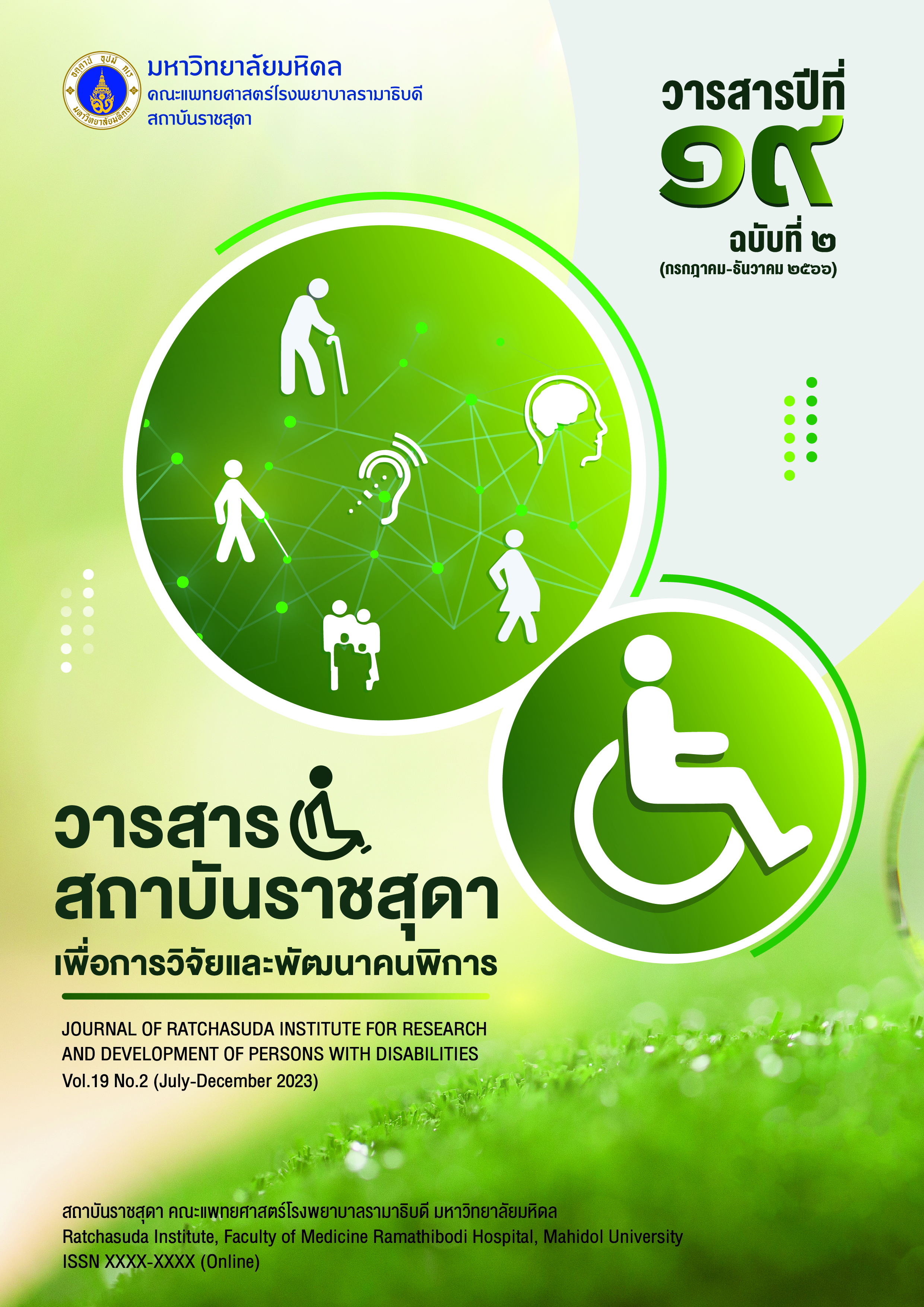The Use of Social Story through Story-Telling along the Simulation to Increase Waiting Skill in a Child with Autism Spectrum Disorder
Keywords:
Social Stories, Waiting Skills, Child with Autism Spectrum DisorderAbstract
This study aimed to study the use of social stories through storytelling with the simulation to increase waiting skills in a 7-year-old female child with Autism Spectrum Disorder (ASD). It was conducted using an ABAB single case design. Specifically, the data were collected without any intervention in the baseline phase (A), while social stories through storytelling with the simulation were used in the intervention phase (B) for a period of 12 times. The research instruments employed in this study were (1) a participant selection form and a basic skill assessment questionnaire, (2) an interview with parents, and (3) a waiting skill assessment questionnaire. The data were analyzed through graph analysis to present the results of changing in waiting skills. The results showed that in the baseline phase (A1), the average score of waiting skill was 0.83. In the treatment phase in which social story through story-telling along with the simulation (B1) was used, the average score of waiting skill increased to 1.26. In the baseline phase (A2) had waiting skill score increase of 1.45. In the second treatment phase in which social story through story-telling along with the simulation (B2) was exercised, the average score of waiting skill increased to 1.79. These results indicated waiting skill of a child increased after using social story through story-telling along with the simulation.
Downloads
References
American Psychiatric Association. (2013). Diagnostic and statistical manual of mental disorders. Arlington,VA: Author.
Delano, M. E. (2007). Video modeling interventions for individuals with autism. Remedial and special education, 28(1), 33–42.
Gray, C. (1991). What Are Social Stories. Thegraycenter. http://www.thegraycenter.org/social-stories/what-are-social-stories/.
Gray, C. (2000). The new social story book illustrated edition. Future Horizons.
Juthapakdeekul, N. (2019). Handbook of Workshop on Assessing the Development of Management Thinking (Executive Function) in early childhood. Institute of Molecular Biosciences, Mahidol University.
Kaplan, H. I., & Sadock, B.J. (1998). Kaplan and Sadock’s Synopsis of Psychiatry. Behavioral Sciences / Clinical Psychiatry (8th ed.). William & Wilkins.
Kazdin, A. E., & Wassell, G. (1998). Treatment completion and therapeutic change among children referred for outpatient therapy. Professional Psychology: Research and practice, 29(4), 332–340.
Khaemmanee, T. (2008). Pedagogical science: Knowledge for an effective learning process. Chulalongkorn University.
Khemphukhieo, A., & Yuankratok, P. (2019). Social skills of school-age autistic children. Journal of Psychiatric and Mental Health Nursing, 30(2), 1-21.
Leitner, Y. (2014). The Co-occurrence of autism and attention deficit hyperactivity disorder in Children - What Do We Know?. Frontiers In Human Neuroscience, 8, 268.
Ongkhasing, H. (2011). Adjusting the waiting behavior of children with autism by using play activities [Unpublished master’s thesis]. Chiang Mai University.
Panyakham, C. (2015). The training of waiting skills of autistic children by using a throwing game. Special education center of Pattani Province.
Phrommanee, P. (2011). Storytelling techniques. GoToKnow. https://www.gotoknow.org/posts/456068
Piyathamwarakul, S. (2018). Development of social skills for children with autism in Ramkhamhaeng University Demonstration School using the social story method. Faculty of Education, Ramkhamhaeng University.
Rayner, C., Denholm, C., & Sigafoos, J. (2009). Video-based intervention for individuals with autism: Key questions that remain unanswered. Research in Autism Spectrum Disorders, 3(2), 291–303.
Secretariat of the Education Council, (2007). A model for promoting reading habits in children aged 1–3 years by parents and caregivers. Graphic Pepper.
Shukla-Mehta, S., Miller, T., & Callahan, K. J. (2010). Evaluating the effectiveness of video instruction on social and communication skills training for children with autism spectrum disorders: A review of the literature. Focus on Autism and Other Developmental Disabilities, 25(1), 23-36.
Sriwiset, K., (2009). Improving social skills for autistic students in co-educational primary school using social stories. Master of Education Thesis, Khon Kaen University.
Supakwatana, P. (2009). Behavioral development of children with autism using the social story method. Bachelor of Science Thesis. Chulalongkorn University.
Wiriyangkun, Y., Napanang, P., & Sinbenjapong, W. (2018). Behavior management for special education teachers. Chiang Mai University.
Downloads
Published
How to Cite
Issue
Section
License
Copyright (c) 2023 Journal Of Ratchasuda Institute for Research and Development of Persons With Disabilities

This work is licensed under a Creative Commons Attribution-NonCommercial-NoDerivatives 4.0 International License.
บทความที่ได้รับการตีพิมพ์เป็นลิขสิทธิ์ของวารสารสถาบันราชสุดาเพื่อการวิจัยและพัฒนาคนพิการ






